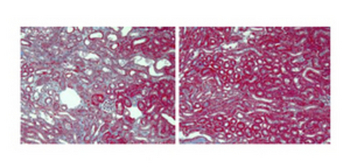
Research Activities
Research Activities
Publications
July 22, 2015
iPSCs show promise for kidney treatment
One promising way to treat diseased or damaged kidneys is cell therapies that include the transplantation of renal progenitor cells, which can then develop into the cells needed for full recovery. Acquiring a sufficient number of progenitor cells has been difficult, however, which is why scientists have considered induced pluripotent stem cells (iPSCs), since they can be expanded at significantly high levels and then differentiated into the progenitors.
In the ideal situation, renal progenitors would be transplanted directly into the kidney parenchyma, but this is never a simple problem. "The kidney is a very solid organ, which makes it very difficult to bring enough number of cells upon transplantation," explains Professor Kenji Osafune, whose lab at the Center for iPS Cell Research and Application (CiRA) at Kyoto University, Japan, is using iPSCs to investigate new treatments for kidney disease. In fact, few studies have managed to transplant the adequate number for treatment.
In a new study in collaboration with Astellas Pharma Inc., the research team led by Osafune showed a circumventive solution. They instead transplanted iPSC-derived renal progenitors into the kidney subcapsule, which is at the kidney surface of a mouse model with acute kidney injury. Even though the transplanted cells never integrated with the host, mice that received this transplant showed better recovery, including less necrosis and fibrosis, compared with mice that received transplants of other cell types. One reason that Osafune attributed to this improvement was the use of cells that expressed Osr1 and Six2. Although these two factors are known markers of renal progenitors, until now researchers had not exclusively used cells that expressed both for cell therapies.
Another conclusion from the study was that because the cells did not integrate into the kidney, their therapeutic effects were the result of paracrine actions that included the secretion of key renoprotective factors. While most stem cell therapies aim for integration, these findings could have important clinical implications. Foremost is that it is one of the first to show the benefits of using human iPS cell-derived renal lineage cells for cell therapy. Second, fibrosis is a marker of progression to chronic kidney disease, suggesting that the paracrine effects could act as preventative therapy for other serious ailments. Finally, Osafune believes these effects could give clues for drug discovery. "There is no medication for acute kidney injury. If we can identify the paracrine factor, maybe it will lead to a drug."

Damaged kidneys (left) show high levels of fibrosis (blue). Treatment with Osr1+Six2+ cell therapy significantly ameliorates the fibrosis (right).
Paper Details
- Journal: Stem Cells Translational Medicine
- Title: Cell therapy using human induced pluripotent stem cell-derived renal progenitors ameliorates acute kidney injury in mice
- Authors: Takafumi Toyohara, Shin-Ichi Mae, Shin-Ichi Sueta, Tatsuyuki Inoue, Yukiko Yamagishi, Tatsuya Kawamoto, Tomoko Kasahara, Azusa Hoshina, Taro Toyoda, Hiromi Tanaka, Toshikazu Araoka, Aiko Sato-Otsubo, Kazutoshi Takahashi, Yasunori Sato, Noboru Yamaji, Seishi Ogawa, Shinya Yamanaka, Kenji Osafune






















